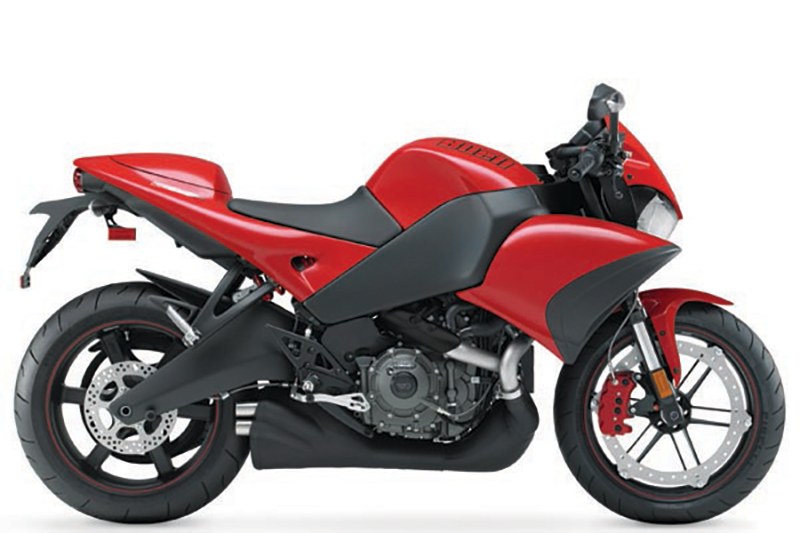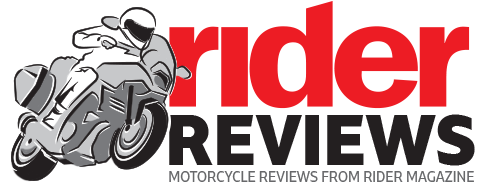2009 Buell 1125CR

Road Test Review
Los Angeles has the Rock Store; Berlin has Spinner-Brücke, a biergarten that has been a motorcycle hangout for 50 years. Harley traditionalists in America often look down their noses at the liquid-cooled V-Rod and sporty Buells; their counterparts in Berlin feel the same way, they just express it with a Hans & Franz accent (“Ja, we will let them live…maybe!”).
After the flack über-American Harley-Davidson got for developing the XR1200 solely for the European market, why would its Buell subsidiary introduce the 1125CR in Berlin? Simple. Buell sells half of its motorcycles in Europe, and café racers (the CR in the model name) were born there. And part of West Berlin was a bastion of American idealism in Soviet-controlled East Germany for four decades. So it’s got that going for it, which is nice.
Like Harley’s V-Rod, the 1125R sportbike introduced in 2007 was Buell’s first venture into liquid-cooled territory. Whether you believe these water-pumpers are expansions into new markets or are preparations for the day when air-cooled engines go the way of the dodo bird depends on which tea leaves you’ve been reading (or smoking). Regardless, according to this performance-oriented non-traditionalist, both the Harley Revolution and Buell Helicon engines are superior to their air-cooled ancestors.
When Rider attended the 1125R introduction, we came away impressed by the ergonomics, wind protection, smooth gearbox and prodigious grunt (Rider, April 2008). But the suspension rates and fuel injection on those preproduction machines had not been finalized, limiting the potential of a bike we considered a “huge step forward” for Buell.
For 2009, the 1125R and 1125CR get targeted fuel injectors, relocated oxygen sensors and new spark and fuel maps. These tweaks are aimed at improving drivability, throttle response, heat management and fuel economy. Other than that, the 1125R is unchanged and the 1125CR stands apart in only a few ways. A flyscreen replaces the bulbous front fairing, clubman bars take the place of clip-ons, a rear seat cowl has been added and final gearing is lower for quicker acceleration.
One wonders, with only minor fueling upgrades and styling differences, why did Buell stage a worldwide press introduction for the 1125CR only one year after the 1125R was released? Perhaps the CR would give Buell a chance to get things right, to show the world that the 1125 Helicon platform is a serious contender.
Under founder/designer Erik Buell’s leadership, the eponymous company’s guiding principles have come to be known as Trilogy of Tech (mass centralization, low unsprung weight and chassis rigidity) and Buell Multifunctional Design, whereby single parts serve multiple purposes to enhance the riding experience.
Considering the first leg of Buell’s techno tripod—mass centralization—the 1125CR is a tight, light package. With a compact 72-degree V-twin, fuel stored in the frame and an underslung exhaust, it is more core-focused than a Pilates instructor. Compared to its sport standard peers tested in our previous issue (Rider, December 2008), the 1125CR’s 54.5-inch wheelbase is 1.7 to 3.0 inches shorter. And with a claimed dry weight of 375 pounds, even guesstimating a generous 75 pounds for fuel, fluids and battery puts it 40 pounds lighter than the 489-pounds-wet Triumph Speed Triple. On the dizzingly detailed spec sheet, seat height is listed as 30.5 inches with a footnote: “Laden, wet configuration (design rider, all fluids).” Since I didn’t take a tape measure to Berlin, I can’t tell you what the seat height would be without some mysterious person’s butt in the saddle.
Unsprung pounds are shed by way of a 47mm Showa male-slider fork (adjustable for preload, compression and rebound, as is the Showa rear shock), cast-aluminum wheels and Buell’s eight-piston, single caliper Zero Torsional Load front brake, which mates up with a 375mm, perimeter-mounted rotor. And to make sure that three-legged stool doesn’t fall over, chassis rigidity comes courtesy of a cast-aluminum frame and swingarm that are as strong as that fräulein on the St. Pauli Girl beer label holding three steins of lager in each hand!
We put Buell’s design principles to the test at Spreewaldring, a tight, 2.7-kilometer racetrack in Waldow. Where’s Waldow? (Sorry, couldn’t resist.) It’s about an hour southeast of Berlin. On the flat, smooth tarmac the 1125CR came out swinging. With a claimed 146 horsepower and 82 lb-ft of torque, it’s got one heck of an uppercut. The Helicon motor sounds and feels great. For comparison purposes, I did a short hop on an XB12S with a 1,203cc air-cooled Thunderstorm engine during the following day’s street ride. The 1125CR revs quicker and higher, pulls harder and doesn’t rattle your fillings loose at idle. A Tyson-style knockout.
Herr Helicon’s closed-loop fuel injection and zaftig 61mm throttle bodies deliver right-now throttle response. Minimalists will want to remove those unsightly tusk-pods hanging off each side of the bike, but they contain ram-air intakes, radiator, ECU and other bits that don’t fit elsewhere on the 1125CR’s svelte figure. Though a bit cramped for my tall frame, the clubman bars force the rider into a racing crouch that works well on the track. For the street, however, the accessory upright handlebar is the way to go ($200 plus installation).
While the racer-journalists on the track were busy stuffing each other in corners, sliding around on the Pirelli Diablo Corsa III tires and, occasionally, testing the off-road capabilities of the 1125CR, I practiced throttle control and tried to look pretty for the camera. In terms of weight and responsiveness, the 1125CR felt like a middleweight sportbike. With a narrow 21-degree rake and a scant 3.3 inches of trail, steering is rabbit quick. Tuned for torsional stiffness and using
the rigidly mounted engine as a stressed member, the frame has six-pack abs. A linkage-less swingarm and male-slider fork round
out what Buell calls the Intuitive Response Chassis. Erik Buell’s racing background clearly shines through on his premier sportbike/café racer. The ZTL front brake was progressive and reassuring, though one of the technicians let it slip that racing brake pads had been installed for the track.
Even with the suspension softened up for the street ride, the 1125CR’s rigid chassis was unforgiving on rough, Eastern-Bloc pavement. Our connect-the-dots route went from village to village, with intermittent blasts through lush farmland. In the center of each town were cobblestone streets preserved for historical and aesthetic reasons. Quaint, but rough on old bones and joints. By the end of the day I rode standing up, dirt-bike style, to give my body a break. Our ride on the autobahn, which included a few klicks with no speed limit, was all too brief. Tucking in behind Erik Buell and passing cars at 240 kph was a memorable experience.
No doubt, the scrappy 1125CR would have been a contender against the Triumph Speed Triple that won our sport standard title fight. Triumph, beware of dark alleys….

